The Legend of Tickle - Postmortem
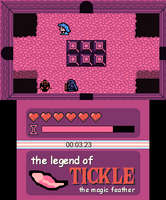
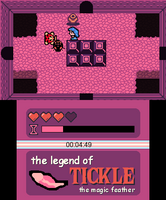
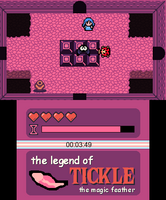
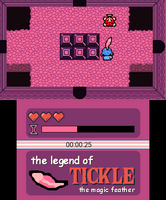
OVERVIEW
The Legend of Tickle: The Magic Feather was an exciting Global Game Jam 2024 project I made that aimed to bring a unique blend of humor and adventure, mainly to the Nintendo 3DS platform—my favorite gaming console ever, but there's a PC version provided as well. As I wrap up my development journey, it's time to reflect on my game jam success, the challenges, and the valuable lessons learned throughout the process.
ZELDA INFLUENCES
The Legend of Tickle: The Magic Feather draws inspiration from the iconic 1993 Game Boy game The Legend of Zelda: Link's Awakening, paying homage to its captivating storytelling, engaging gameplay, and charming world design. This influence served as a guiding light in shaping the narrative and gameplay mechanics of my own Global Game Jam 3DS adventure.
The art style of The Legend of Tickle pays homage to the charming pixel art of Link's Awakening, evoking a sense of nostalgia for fans of classic Zelda titles. The visuals are crafted to capture the same magical essence that made the worlds of Hyrule and Koholint Island unforgettable. In fact, most of the sprites in The Legend of Tickle were traced over their Link's Awakening counterparts and then upscaled with Aseprite's RotSprite at 2x the original resolution - Lily was traced from Marin, Octoroths are basically just Octoroks, Battons are Battle Bats, Diggers were drawn over Leevers, and Teutons are sloppily redrawn Darknuts.
While inspired by The Legend of Zelda: Link's Awakening, I faced the challenge of fitting the Zelda-style mechanics & gameplay into the Global Game Jam's theme, Make Me Laugh. Integrating the tickling mechanic required careful consideration to ensure it fit the game jam's theme and complemented the nostalgic elements of Zelda games.
CODE REUSE
In the development of The Legend of Tickle: The Magic Feather for the Nintendo 3DS, one of the key strategies employed to make it in the allotted game jam time, was the reuse of code from a previous successful Nintendo 3DS project, Attack of the Martians: Remastered. Leveraging existing code for things like the transitions, sound handling, map loading, the object system, the trigonometry helper functions & Pico-8 table handling helper functions ported to LÖVE2D proved to be a time-efficient and effective way to address certain technical challenges and enhance the overall quality of the game.
Code reuse significantly reduced development time, allowing me to focus on refining and expanding the unique aspects of The Legend of Tickle. This efficiency was crucial in meeting game jam deadlines and ensuring a timely release
While reusing code, I encountered the challenge of adapting certain elements to fit the new theme and completely different, top-down mechanics of The Legend of Tickle. This required careful customization to ensure that the reused code seamlessly integrated with the new game's design and narrative.
LILY'S TRANSGENDER IDENTITY
From the inception of "The Legend of Tickle: The Magic Feather," a crucial aspect of the game's narrative was intended to revolve around Lily's transgender identity. As you might notice, Lily is based off me, the creator of the game - I am a transgender woman myself. The initial vision embraced a compelling plotline where Lily, the trans protagonist, embarks on a heroic journey to confront and combat transphobia. The ambitious narrative aimed to delve into social issues, portraying Lily as a symbol of resilience and empowerment, rescuing trans women locked in cages within a metaphorical dungeon and fighting a powerful transphobic boss at the end of the dungeon.
However, the development journey unfolded with its set of challenges and time constraints. The intricate narrative I envisioned, with its broader social commentary and nuanced exploration of transgender issues, faced limitations within the project's timeline. As a result, the envisioned plot evolved into a more streamlined experience, manifesting as an arena battler within the constraints of available resources
While the grand narrative had to be scaled down, the essence of Lily's identity remains present in the game. The arena battler format became a focused and intense platform for players to engage with Lily's character in a combat setting. The battles, though condensed, provide players with an opportunity to experience Lily's strength and determination firsthand, and the transgender identity of our character is still present in the form of a transgender flag colored background for the in-game timer
TICKLING INSPIRATION
The Legend of Tickle: The Magic Feather emerges from a unique and somewhat unconventional source of inspiration—the creator's personal experiences with tickling. In this whimsical journey, the game's development was profoundly influenced by a genuine obsession with the playful and lighthearted act of tickling.
The creator's fascination with tickling manifested as a driving force behind the game's central mechanic. Drawing inspiration from the delightful and often underestimated joy of tickling, the gameplay took an unexpected turn. Instead of conventional combat or puzzle-solving, players find themselves engaging in hilarious battles where the protagonist, Lily, uses a magic feather to tickle her way to victory.
While unconventional, the game's theme has become a source of joy and amusement for both the creator and players alike. The decision to build an entire game around this quirky fascination speaks to the creative freedom and individuality that game development can embrace. It's a reminder that inspiration can come from the most unexpected places, and a personal passion can be the spark that fuels a unique and entertaining gaming experience.
3DS-FIRST DESIGN
The Legend of Tickle: The Magic Feather wasn't just a game jam entry; it was a heartfelt ode to a cherished companion—the Nintendo 3DS. I meticulously crafted this whimsical adventure with a "3DS first" design philosophy, stemming from the deep affection I have for this beloved gaming console, that brought us games like The Legend of Zelda: A Link Between Worlds, New Super Mario Bros., WarioWare Gold or Nintendogs + Cats, games that I wanted to invoke the feel, the fun and the whimsical childish playfulness of, when developing The Legend of Tickle.
From the game's conception, my vision was clear—immerse players in a delightful experience tailor-made for the 3DS. Every pixel, every tickle, and every quirky mechanic was carefully considered through the lens of the 3DS, a console that had etched countless memorable moments in my gaming journey.
The design decisions revolved around leveraging the unique features of the 3DS. The dual screens became canvases for captivating visuals, creating an immersive world that spilled seamlessly across both displays. The stylus, a trusty companion for 3DS enthusiasts, found new purpose in guiding Lily's tickling magic across the screen—in the game, the player literally tickles the bottom screen to tickle the in-game enemies.
This "3DS first" approach wasn't just about technical considerations; it was a love letter to the Nintendo community and the console I adore. My passion for Nintendo and games developed by them seeped into the very fabric of this game, creating a shared experience for those who, like me, hold Nintendo and the 3DS close to their hearts.
PC PORT
Let's address the elephant in the room - the PC version is, in essence, just a humble companion to the 3DS version of the game. The limitations imposed by a keyboard, starkly different from the tactile finesse of the 3DS controls, became evident. The magic of tickling, once an personal, intimate experience on handheld screens, found itself relegated to the impersonal press of a key.
In the PC port, the Right Shift key assumed the role of the tickling catalyst, to make the game still playable with a single hand. An arbitrary choice, dictated by the keyboard's limitations, it now stands as a functional but far cry from the nuanced experience intended for the 3DS. Ticking enemies lost the tactile joy of stylus strokes and physical engagement, replaced by the staccato rhythm of keyboard taps
In the world of game development, every compromise is a lesson, and every choice shapes the narrative. The Right Shift key may not be the stylus dance envisioned for the Nintendo 3DS, but it is a testament to adaptation, resilience, and the commitment to sharing Lily's tickling escapades with a broader audience.
So, with a sense of both humility and pragmatism, I invite players to indulge in the PC version as well. It may not be the 3DS experience, but within its keystrokes lies the same enchantment, the same laughter, and the same journey through the whimsical world of tickling magic.
DIVERSIFIERS USED
In the creative tapestry of game development, the Global Game Jam diversifiers serve as brushstrokes that add unique hues to the canvas of beautiful, hand-crafted jam entries. For The Legend of Tickle: The Magic Feather, a deliberate effort was made to infuse diversity into my game through carefully chosen diversifiers, each contributing to a more enjoyable journey.
For this game jam, I used 3 diversified offered by Global Game Jam's organizers.
1. Lunch Special - Playable with One Hand:
The "Lunch Special" diversifier brought forth a challenge that redefined the traditional gaming experience. With the goal of making the game playable with just one hand, a new layer of accessibility unfolded. Players engaging in ticklish battles, could now do so with ease, embracing the game's whimsy without the need for both hands on the controls. This was done by mirroring the same controls on the both sides of the 3DS console, and by binding tickling to Right Shift, near the arrows used for controlling the character, on the PC.
2. Mouthing Off - All Audio with Your Mouth
"Mouthing Off" transformed the auditory landscape of the game, where every sound effect and ticklish giggle was crafted using my mouth. Beyond just being a fun game jam experience, I used this diversifier for a celebration of self-expression, featuring my beautiful trained transgender woman voice for the player's giggles and the sound effects. For the enemies' giggles, I changed the pitch of my giggles. This diversifier was an opportunity for some fun in creating the game audio and, in doing so, to share a personal touch as well.
3. What You Don't Know Can't Help You - Playable for Disabled People:
The diversifier "What You Don't Know Can't Help You" emphasized inclusivity by making the game playable for disabled individuals, addressing a broader audience and ensuring that the enchanting world of tickling magic was accessible to all. This diversifier was not just a checkbox; it was a conscious effort to break down barriers and make gaming a more inclusive space
As the creator, it is my hope that these diversifiers added some new, unconventional layers of enjoyment to the gaming experience.
SUMMARY
With heartfelt gratitude and a sense of fulfillment, I bring the curtain down on the postmortem of The Legend of Tickle: The Magic Feather. This whimsical journey from concept to creation, filled with laughter, challenges, and heartfelt diversifiers, stands as a testament to the vibrant spirit of indie game development.
May your journey be filled with laughter, may your tickles be triumphant, and may the magic of gaming continue to inspire and unite us all.
Files
Get The Legend of Tickle: The Magic Feather
The Legend of Tickle: The Magic Feather
A game about tickling your enemies to death!
| Status | Released |
| Author | Extremely Awesome Games |
| Genre | Action, Survival |
| Tags | 2D, Cute, ggj2024, Homebrew, LÖVE, nintendo3ds, poznangamejam2024, Singleplayer |
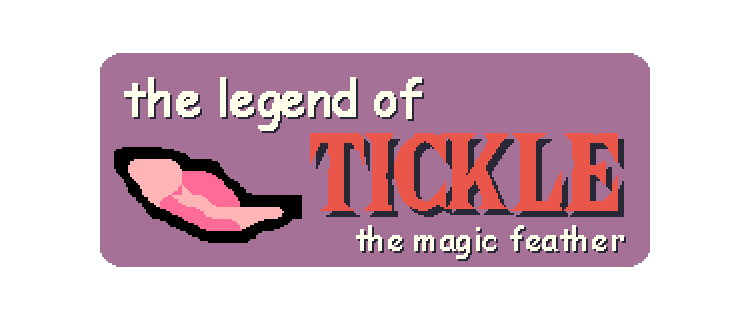
Leave a comment
Log in with itch.io to leave a comment.